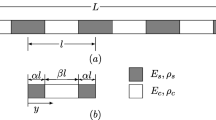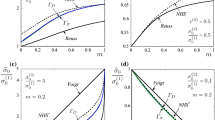Abstract
Peridynamics is a nonlocal continuum model which offers benefits over classical continuum models in cases, where discontinuities, such as cracks, are present in the deformation field. However, the nonlocal characteristics of peridynamics leads to a dispersive dynamic response of the medium. In this study we focus on the dispersion properties of a state-based linear peridynamic solid model and specifically investigate the role of the peridynamic horizon. We derive the dispersion relation for one, two and three dimensional cases and investigate the effect of horizon size, mesh size (lattice spacing) and the influence function on the dispersion properties. We show how the influence function can be used to minimize wave dispersion at a fixed lattice spacing and demonstrate it qualitatively by wave propagation analysis in one- and two-dimensional models of elastic solids. As a main contribution of this paper, we propose to associate peridynamic non-locality expressed by the horizon with a characteristic length scale related to the material microstructure. To this end, the dispersion curves obtained from peridynamics are compared with experimental data for two kinds of sandstone.














Similar content being viewed by others
References
Amani J, Oterkus E, Areias P, Zi G, Nguyen-Thoi T, Rabczuk T (2016) A non-ordinary state-based peridynamics formulation for thermoplastic fracture. Int J Impact Eng 87:83–94
Bažant ZP (1991) Why continuum damage is nonlocal: micromechanics arguments. J Eng Mech 117(5):1070–1087
Bažant ZP, Luo W, Chau VT, Bessa MA (2016) Wave dispersion and basic concepts of peridynamics compared to classical nonlocal damage models. J Appl Mech 83(11):111004
Drugan WJ, Willis JR (1996) A micromechanics-based nonlocal constitutive equation and estimates of representative volume element size for elastic composites. J Mech Phys Solids 44(4):497–524
Emmrich E, Weckner O et al (2007) On the well-posedness of the linear peridynamic model and its convergence towards the navier equation of linear elasticity. Commun Math Sci 5(4):851–864
Eringen AC (2002) Nonlocal continuum field theories. Springer Science & Business Media, New York
Foster JT, Silling SA, Chen W (2010) Viscoplasticity using peridynamics. Int J Numer Meth Eng 81(10):1242–1258
Gerstle W, Sau N, Aguilera E (2007) Micropolar peridynamic modeling of concrete structures. In: Proceedings of the 6th international conference on fracture mechanics of concrete structures
Gerstle W, Sau N, Silling S (2007) Peridynamic modeling of concrete structures. Nucl Eng Des 237(12):1250–1258
Grane F (1961) Measurements of transverse dispersion in granular media. J Chem Eng Data 6(2):283–287
Gu X, Zhang Q, Huang D, Yv Y (2016) Wave dispersion analysis and simulation method for concrete shpb test in peridynamics. Eng Fract Mech 160:124–137
Ha YD, Bobaru F (2010) Studies of dynamic crack propagation and crack branching with peridynamics. Int J Fract 162(1–2):229–244
Jirasek M (2004) Nonlocal theories in continuum mechanics. Acta Polytech 44(5–6):16–34
Le QV, Chan WK, Schwartz J (2014) A two-dimensional ordinary, state-based peridynamic model for linearly elastic solids. Int J Numer Meth Eng 98(8):547–561
Madenci E, Oterkus S (2016) Ordinary state-based peridynamics for plastic deformation according to von mises yield criteria with isotropic hardening. J Mech Phys Solids 86:192–219
Mitchell JA (2011) A non-local, ordinary-state-based viscoelasticity model for peridynamics. Sandia Natl Lab Rep 8064:1–28
Mitchell JA (2011) A nonlocal, ordinary, state-based plasticity model for peridynamics. In: SAND report, 3166
Ren H, Zhuang X, Cai Y, Rabczuk T (2016) Dual-horizon peridynamics. Int J Numer Meth Eng 108(12):1451–1476
Seleson P, Parks M (2011) On the role of the influence function in the peridynamic theory. Int J Multiscale Comput Eng 9(6):689–706
Seleson P, Parks ML, Gunzburger M, Lehoucq RB (2009) Peridynamics as an upscaling of molecular dynamics. Multiscale Model Simul 8(1):204–227
Silling SA (2000) Reformulation of elasticity theory for discontinuities and long-range forces. J Mech Phys Solids 48(1):175–209
Silling SA (2010) Linearized theory of peridynamic states. J Elast 99(1):85–111
Silling SA, Askari E (2005) A meshfree method based on the peridynamic model of solid mechanics. Comput Struct 83(17):1526–1535
Silling SA, Epton M, Weckner O, Xu J, Askari E (2007) Peridynamic states and constitutive modeling. J Elast 88(2):151–184
Silling SA, Silling RB (2008) Convergence of peridynamics to classical elasticity theory. J Elast 93(1):13–37
Timothy JJ, Meschke G (2016) A cascade continuum micromechanics model for the elastic properties of porous materials. Int J Solids Struct 83:1–12
Timothy JJ, Meschke G (2016) Cascade lattice micromechanics model for the effective permeability of materials with microcracks. J Nanomech Micromech (ASCE) 6(4):04016009
Weckner O, Abeyaratne R (2005) The effect of long-range forces on the dynamics of a bar. J Mech Phys Solids 53(3):705–728
Weckner O, Brunk G, Epton MA, Silling SA, Askari E (2009) Comparison between local elasticity and non-local peridynamics. Sandia Natl Lab Rep J 1109:2009
Weckner O, Silling SA (2011) Determination of nonlocal constitutive equations from phonon dispersion relations. Int J Multiscale Comput Eng 9(6):39–52
Wildman RA, Gazonas GA (2014) A finite difference-augmented peridynamics method for reducing wave dispersion. Int J Fract 190(1–2):39–52
Willis JR (1985) The nonlocal influence of density variations in a composite. Int J Solids Struct 21(7):805–817
Winkler KW (1983) Frequency dependent ultrasonic properties of high-porosity sandstones. Journal of Geophysical Research: Solid. Earth 88(B11):9493–9499
Zhang JJ, Bentley LR (1999) Change of bulk and shear moduli of dry sandstone with effective pressure and temperature. CREWES Res Rep 11:01–16
Zimmermann M (2005) A continuum theory with long-range forces for solids. PhD thesis, Massachusetts Institute of Technology
Acknowledgements
The support provided by the German Science Foundation (DFG) in the framework of Project C4 of the Collaborative Research Center SFB 837 ‘Interaction modeling in mechanized tunneling’ is gratefully acknowledged. The authors would also like to thank Prof. Klaus Hackl, Dr. Pablo Seleson, Prof. Ralf Jänicke and Dr. David Littlewood for many helpful discussions.
Author information
Authors and Affiliations
Corresponding author
Rights and permissions
About this article
Cite this article
Butt, S.N., Timothy, J.J. & Meschke, G. Wave dispersion and propagation in state-based peridynamics. Comput Mech 60, 725–738 (2017). https://doi.org/10.1007/s00466-017-1439-7
Received:
Accepted:
Published:
Issue Date:
DOI: https://doi.org/10.1007/s00466-017-1439-7




